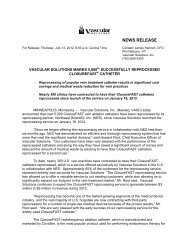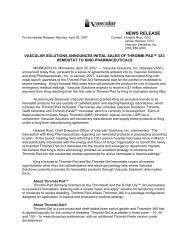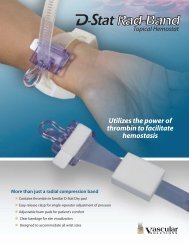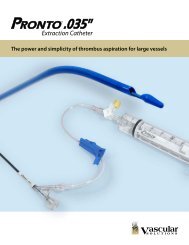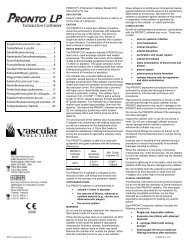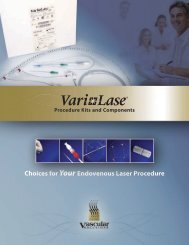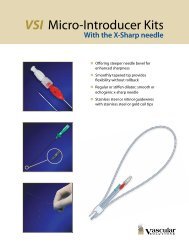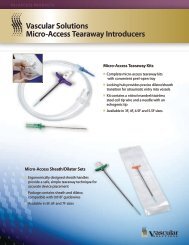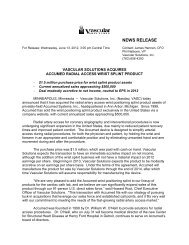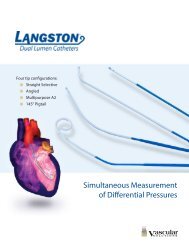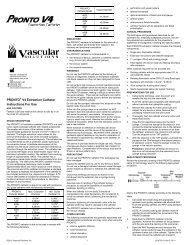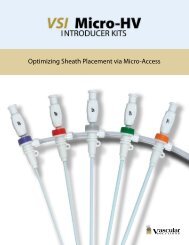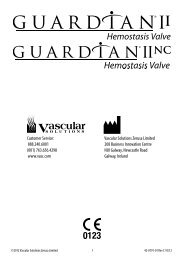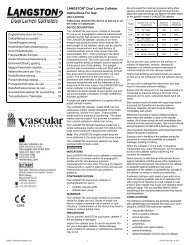D-Stat® Rad-Band Topical Hemostat Model 3501 Instructions For Use
D-Stat® Rad-Band Topical Hemostat Model 3501 Instructions For Use
D-Stat® Rad-Band Topical Hemostat Model 3501 Instructions For Use
Create successful ePaper yourself
Turn your PDF publications into a flip-book with our unique Google optimized e-Paper software.
English/<strong>Instructions</strong> for <strong>Use</strong> ........................ 1<br />
Español/Instrucciones de uso ................... 2<br />
D-Stat ® <strong>Rad</strong>-<strong>Band</strong> <strong>Topical</strong> <strong>Hemostat</strong><br />
<strong>Model</strong> <strong>3501</strong><br />
<strong>Instructions</strong> <strong>For</strong> <strong>Use</strong><br />
USA CAUTION<br />
Federal (USA) law restricts this device to sale by or on the<br />
order of a physician.<br />
CAUTION<br />
The D-Stat <strong>Rad</strong>-<strong>Band</strong> procedure should be performed by<br />
physicians or physician-directed allied health care<br />
professionals with adequate training in the use of the<br />
device.<br />
DEVICE DESCRIPTION<br />
Each D-Stat <strong>Rad</strong>-<strong>Band</strong> consists of the following<br />
components:<br />
Application device consisting of a Lyophilized<br />
D-Stat <strong>Rad</strong>-<strong>Band</strong> pad containing thrombin,<br />
sodium carboxylmethylcellulose and calcium<br />
chloride in a nonwoven gauze, an adjustable<br />
retention strap and attached foam comfort pads<br />
<br />
Adhesive bandage<br />
Thrombin is a protein substance produced through a<br />
conversion reaction in which prothrombin of bovine origin is<br />
activated by tissue thromboplastin of bovine origin in the<br />
presence of calcium chloride. Thrombin contains no<br />
preservative and has been chromatographically purified.<br />
Thrombin requires no intermediate physiological agent for its<br />
reaction. It converts fibrinogen directly to fibrin. This product<br />
contains not less than 200 units of bovine derived thrombin.<br />
Sodium carboxymethylcellulose, also known as cellulose<br />
gum or CMC, serves as the matrix for the lyophilized pad<br />
and as a suspension agent for the thrombin.<br />
Hemostasis is achieved by the physiological coagulationinducing<br />
properties of the lyophilized pad combined with<br />
the compression delivered by the application device.<br />
The D-Stat <strong>Rad</strong>-<strong>Band</strong> has been sterilized with irradiation.<br />
INDICATIONS<br />
The D-Stat <strong>Rad</strong>-<strong>Band</strong> is applied topically and is indicated<br />
for the control of surface bleeding from vascular access<br />
sites and percutaneous catheters or tubes.<br />
CONTRAINDICATIONS<br />
The D-Stat <strong>Rad</strong>-<strong>Band</strong> is contraindicated in persons with<br />
known sensitivity to bovine-derived materials.<br />
WARNINGS<br />
Do not place the lyophilized pad of the D-Stat <strong>Rad</strong>-<strong>Band</strong><br />
into blood vessels. Extensive intravascular clotting and<br />
even death may result.<br />
Do not apply occlusive pressure using the D-Stat <strong>Rad</strong>-<br />
<strong>Band</strong>. Arterial damage and thrombosis may result. Check<br />
pulses frequently to maintain arterial flow, and loosen the<br />
retention strap as necessary.<br />
Do not leave the adhesive bandage attached for more than<br />
24 hours. Skin irritation may result.<br />
The use of topical bovine thrombin preparations has<br />
occasionally been associated with abnormalities in<br />
hemostasis ranging from asymptomatic alterations in<br />
laboratory determinations, such as prothrombin time<br />
(PT) and partial thromboplastin time (PTT), to severe<br />
bleeding or thrombosis which rarely have been fatal.<br />
These hemostatic effects appear to be related to the<br />
formation of antibodies against bovine thrombin and/or<br />
factor V which in some cases may cross react with<br />
human factor V, potentially resulting in factor V<br />
deficiency. Repeated clinical applications of topical<br />
bovine thrombin increase the likelihood that antibodies<br />
against thrombin and/or factor V may be formed.<br />
Consultation with an expert in coagulation disorders is<br />
recommended if a patient exhibits abnormal<br />
coagulation laboratory values, abnormal bleeding, or<br />
abnormal thrombosis following the use of topical<br />
thrombin. Any interventions should consider the<br />
immunologic basis of this condition. Patients with<br />
antibodies to bovine thrombin preparations should not<br />
be re-exposed to these products.<br />
The D-Stat <strong>Rad</strong>-<strong>Band</strong> is supplied sterile for single use only.<br />
Do not re-sterilize.<br />
PRECAUTIONS<br />
Do not use the D-Stat <strong>Rad</strong>-<strong>Band</strong> if the packaging has been<br />
damaged.<br />
The D-Stat <strong>Rad</strong>-<strong>Band</strong> should not be used in the presence<br />
of infection.<br />
It should be used with caution in contaminated areas of the<br />
body.<br />
Do not touch the D-Stat <strong>Rad</strong>-<strong>Band</strong> lyophilized pad with wet<br />
gloves or expose the pad to liquid. Absorption of the liquid<br />
and destruction of the pad will result.<br />
ADVERSE EVENTS<br />
A recognized rare potential reaction associated with the<br />
use of bovine derived thrombin is the development of<br />
inhibitory antibodies, which interferes with hemostasis.<br />
Other potential adverse events include allergic reaction or<br />
radial artery occlussion, local venous thrombosis,<br />
hematoma formation, recurrent bleeding, peripheral nerve<br />
damage and complex regional pain syndrome.<br />
CLINICAL PROCEDURE<br />
The following instructions provide technical direction but do<br />
not obviate the necessity of formal training in the use of the<br />
D-Stat <strong>Rad</strong>-<strong>Band</strong>. The techniques and procedures<br />
described do not represent ALL medically acceptable<br />
protocols, nor are they intended to be a substitute for the<br />
physician’s experience and judgment in treating any<br />
specific patient.<br />
Carefully inspect the D-Stat <strong>Rad</strong>-<strong>Band</strong> packaging and<br />
components for damage prior to use.<br />
APPLICATION PROCEDURE<br />
1. Using sterile technique, open the foil pouch and<br />
transfer the D-Stat <strong>Rad</strong>-<strong>Band</strong> into the sterile field.<br />
Precaution: Do not touch the D-Stat <strong>Rad</strong>-<strong>Band</strong><br />
lyophilized pad with wet gloves or expose the pad to<br />
liquid. Absorption of the liquid and destruction of the<br />
lyophilized pad will result.<br />
2. Place the D-Stat <strong>Rad</strong>-<strong>Band</strong> around the patient’s<br />
forearm with the D-Stat <strong>Rad</strong>-<strong>Band</strong> pad over the<br />
access site and the clasp on the thumb side of the<br />
forearm.<br />
3. Secure the D-Stat <strong>Rad</strong>-<strong>Band</strong> loosely around the<br />
forearm by threading the retention strap through the<br />
opening in the clasp and gently pulling the strap.<br />
The foam pads may be adjusted along the bony<br />
prominences of the patient’s wrist to minimize patient<br />
discomfort when the band is tightened.<br />
4. As the introducer sheath or needle is removed, apply<br />
non-occlusive manual compression by placing the D-<br />
Stat <strong>Rad</strong> <strong>Band</strong> pad directly over the source of the<br />
bleeding.<br />
5. Tighten the D-Stat <strong>Rad</strong>-<strong>Band</strong> by pulling on the<br />
retention strap until the device is secure on the<br />
patient’s wrist and the cessation of bleeding is<br />
observed, but the presence of pulses are still<br />
present.<br />
Warning: Do not apply occlusive pressure using the D-<br />
Stat <strong>Rad</strong>-<strong>Band</strong>. Arterial damage and thrombosis may<br />
result. Check pulses frequently to maintain arterial<br />
flow, and loosen the retention strap as necessary.<br />
6. Monitor the site per institutional protocol.<br />
7. Observe for hemostasis by loosening the retention<br />
strap gradually. To loosen or remove the retention<br />
strap, compress the protruding tab on the clasp and<br />
slowly loosen the strap to the desired tension.<br />
8. Once hemostasis is achieved either:<br />
Carefully remove the D-Stat <strong>Rad</strong>-<strong>Band</strong>, being<br />
careful not to disrupt the clot , and dispose of it<br />
properly. Apply dressing of choice.<br />
OR<br />
Secure the D-Stat <strong>Rad</strong>-<strong>Band</strong> pad by applying<br />
slight compression directly on the retainer while<br />
sliding the retention strap out of the side groove<br />
on the retainer. Apply downward pressure on<br />
the release tab of the D-Stat <strong>Rad</strong>-<strong>Band</strong> pad with<br />
one hand. With the other hand slowly pull the<br />
retainer back leaving the D-Stat <strong>Rad</strong>-<strong>Band</strong> pad<br />
in place and being careful not to disrupt the clot.<br />
Apply the adhesive bandage over the pad.<br />
Warning: Do not leave the adhesive bandage attached<br />
for more than 24 hours. Skin irritation may result.<br />
Upon removing the adhesive bandage, do not disrupt the<br />
clot by physical manipulation. If the adhesive bandage<br />
adheres to the placement site, gently irrigate the bandage<br />
with non-heparinized saline and carefully remove it.<br />
3M Tegaderm Transparent Film Dressing Frame<br />
Style<br />
1626, 1627, 1628, 1629, 1630, 1634, 1622W, 1623W,<br />
1624W, 1626W, 9505W, 9506W<br />
Description: Tegaderm Film consists of a thin film<br />
backing with a non-latex, hypoallergenic adhesive.<br />
Tegaderm Film with Border is notched and reinforced<br />
with soft cloth tape to provide a better seal around<br />
catheters and other devices. The dressing is breathable,<br />
allowing good oxygen and moisture vapor exchange. It is<br />
waterproof and impermeable to liquids, bacteria, and<br />
viruses. *An intact dressing protects the site from outside<br />
contamination.<br />
*In vitro testing shows that the film of Tegaderm and<br />
Tegaderm HP dressings provides a viral barrier from<br />
viruses 27nm in diameter or larger while the dressing<br />
remains intact without leakage.<br />
Indications: Tegaderm Film can be used to cover and<br />
protect catheter sites and wounds, to maintain a moist<br />
environment for wound<br />
healing or to facilitate autolytic debridement, as<br />
a secondary dressing, as a protective cover over at-risk<br />
skin, to secure devices to the skin,<br />
to cover first and second degree burns, and as<br />
a protective eye covering. Do not use the dressing as a<br />
replacement for sutures and other primary wound closure<br />
methods.<br />
Precautions:<br />
1. Stop any bleeding at the site before applying the<br />
dressing.<br />
2. Do not stretch the dressing during application as<br />
tension can cause skin trauma.<br />
3. Make sure the skin is clean, free of soap residue and<br />
lotion and allowed to dry thoroughly before applying<br />
the dressing to prevent skin irritation and to ensure<br />
good adhesion.<br />
©2011 Vascular Solutions, Inc. 1<br />
42-0700-01 Rev F 08/11
4. The dressing may be used on an infected site, only<br />
when under the care of a health care professional.<br />
5. Antimicrobial ointments containing polyethylene<br />
glycols may compromise the strength of the<br />
Tegaderm HP Transparent Film Dressings.<br />
6. Tegaderm Transparent Dressings should not be<br />
re-sterilized by gamma, E-beam or steam methods.<br />
<strong>Instructions</strong> for <strong>Use</strong>: Refer to figures.<br />
If you have any questions or comments, contact the 3M<br />
Health Care Customer Help Line at<br />
1-800-228-3957 OR GO TO WWW.3M.COM.<br />
LIMITED WARRANTY<br />
Vascular Solutions, Inc. warrants that the<br />
D-Stat <strong>Rad</strong>-<strong>Band</strong> topical hemostat is free from defects in<br />
workmanship and materials prior to the stated expiration<br />
date. Liability under this warranty is limited to refund or<br />
replacement of any product which has been found by<br />
Vascular Solutions, Inc. to be defective in workmanship or<br />
materials. Vascular Solutions, Inc. shall not be liable for<br />
any incidental, special, or consequential damages arising<br />
from the use of the D-Stat <strong>Rad</strong>-<strong>Band</strong> topical hemostat.<br />
Damage to the product through misuse, alteration,<br />
improper storage, or improper handling shall void this<br />
limited warranty.<br />
No employee, agent, or distributor of Vascular Solutions,<br />
Inc. has any authority to alter or amend this limited<br />
warranty in any respect. Any purported alteration or<br />
amendment shall not be enforceable against Vascular<br />
Solutions, Inc.<br />
THIS WARRANTY IS EXPRESSLY IN LIEU OF ALL<br />
OTHER WARRANTIES, EXPRESSED OR IMPLIED,<br />
INCLUDING ANY WARRANTY OF MERCHANTABILITY<br />
OR FITNESS FOR A PARTICULAR PURPOSE OR ANY<br />
OTHER OBLIGATION OF VASCULAR SOLUTIONS, INC.<br />
PATENTS AND TRADEMARKS<br />
International and U.S. patents pending.<br />
D-Stat ® is a registerd trademark of Vascular Solutions, Inc.<br />
<strong>Band</strong>a radial hemostática tópica D-Stat ®<br />
<strong>Rad</strong>-<strong>Band</strong><br />
<strong>Model</strong>o <strong>3501</strong><br />
Instrucciones de uso<br />
PRECAUCIÓN PARA LOS EE.UU.<br />
Las leyes federales de los EE.UU. restringen la venta de<br />
este dispositivo a médicos o por solicitud de un médico.<br />
PRECAUCIÓN<br />
La colocación de la banda radial D-Stat <strong>Rad</strong>-<strong>Band</strong> debe<br />
ser realizada por médicos, o profesionales auxiliares<br />
dirigidos por un médico, que hayan sido adecuadamente<br />
entrenados en el uso de este dispositivo.<br />
DESCRIPCIÓN DEL DISPOSITIVO<br />
Cada banda D-Stat <strong>Rad</strong> <strong>Band</strong> está formada por los<br />
siguientes componentes:<br />
Dispositivo de aplicación formado por una<br />
compresa liofilizada D-Stat <strong>Rad</strong>-<strong>Band</strong> con<br />
contenido de trombina, carboximetilcelulosa<br />
sódica y cloruro de calcio en gasa no tejida,<br />
una correa de retención ajustable y compresas<br />
de espuma adheridas<br />
<br />
Vendaje adhesivo<br />
La trombina es una es una sustancia proteica producida a<br />
través de una reacción de conversión en la cual la<br />
protrombina de origen bovino es activada por<br />
tromboplastina tisular, también de origen bovino, en<br />
presencia de cloruro de calcio. La trombina no contiene<br />
conservantes y ha sido purificada mediante cromatografía.<br />
La trombina no necesita agentes fisiológicos<br />
intermediarios para la reacción; convierte directamente el<br />
fibrinógeno en fibrina. Este producto contiene al menos<br />
200 unidades de trombina de procedencia bovina.<br />
La carboximetilcelulosa sódica, también conocida como<br />
goma de celulosa o CMC, sirve como matriz para la<br />
compresa liofilizada y como medio de suspensión para la<br />
trombina.<br />
La hemostasis se logra mediante las propiedades<br />
fisiológicas de inducción de la coagulación de la compresa<br />
liofilizada combinada con la compresión producida por el<br />
dispositivo de aplicación.<br />
La banda radial D-Stat <strong>Rad</strong>-<strong>Band</strong> está esterilizada por<br />
radiación.<br />
INDICACIONES<br />
La banda D-Stat <strong>Rad</strong>-<strong>Band</strong> se aplica en forma tópica y<br />
está indicada para el control de hemorragias superficiales<br />
de sitios de acceso vascular y catéteres o tubos<br />
percutáneos.<br />
CONTRAINDICACIONES<br />
La banda radial D-Stat <strong>Rad</strong>-<strong>Band</strong> está contraindicada para<br />
personas con sensibilidad conocida a sustancias de<br />
procedencia bovina.<br />
ADVERTENCIAS<br />
No coloque la compresa liofilizada de la banda D-Stat<br />
<strong>Rad</strong>-<strong>Band</strong> dentro de un vaso sanguíneo. Esto podría<br />
provocar una coagulación intravascular importante o<br />
incluso la defunción del paciente.<br />
No aplique presión oclusiva con la banda D-Stat <strong>Rad</strong>-<br />
<strong>Band</strong>. Podría dañar las arterias y causar una trombosis.<br />
Verifique el pulso con frecuencia para mantener el flujo<br />
arterial y afloje la correa de retención de ser necesario.<br />
El uso de preparaciones tópicas de trombina bovina<br />
se ha asociado, en ocasiones, con anormalidades en<br />
la hemostasis, que abarcan desde alteraciones<br />
asintomáticas en las determinaciones de laboratorio,<br />
tales como el tiempo de protrombina (PT) y el tiempo<br />
parcial de tromboplastina (PTT), hasta hemorragias o<br />
trombosis graves que rara vez tienen un carácter<br />
fatal. Estos efectos hemostáticos parecen estar<br />
relacionados con la formación de anticuerpos contra<br />
la trombina y/o el factor V bovino que, en algunos<br />
casos, pueden presentar una reacción cruzada con<br />
el factor V humano, lo que a su vez puede dar lugar<br />
a una deficiencia de factor V. Las aplicaciones<br />
clínicas repetidas de trombina tópica de origen<br />
bovino aumentan la probabilidad de formación de<br />
anticuerpos contra la trombina y/o el factor V. Se<br />
recomienda consultar a un experto en trastornos de<br />
la coagulación si un paciente presenta valores de<br />
coagulación anormales en los análisis de laboratorio,<br />
excesiva pérdida de sangre o trombosis anormal tras<br />
el uso de trombina tópica. Todas las intervenciones<br />
deben tener en cuenta la base inmunológica de este<br />
trastorno. Los pacientes con anticuerpos contra las<br />
preparaciones de trombina bovina no deben ser<br />
expuestos de nuevo a estos productos.<br />
La banda radial D-Stat <strong>Rad</strong>-<strong>Band</strong> se suministra estéril y<br />
está indicada para un solo uso. No reesterilizar.<br />
PRECAUCIONES<br />
No utilice la banda D-Stat <strong>Rad</strong>-<strong>Band</strong> si el envase presenta<br />
daños.<br />
Si existe infección, no debe usarse la banda D-Stat <strong>Rad</strong>-<br />
<strong>Band</strong>.<br />
Debe utilizarse con precaución en áreas del cuerpo que<br />
estén contaminadas.<br />
No toque la compresa liofilizada de la banda D-Stat <strong>Rad</strong>-<br />
<strong>Band</strong> con los guantes húmedos ni deje que entre en<br />
contacto con líquidos. Esto provocaría la absorción del<br />
líquido y la destrucción de la compresa.<br />
No deje el vendaje adhesivo aplicado durante más de 24<br />
horas. Esto podría ocasionar una irritación cutánea.<br />
REACCIONES ADVERSAS<br />
Una reacción potencial conocida, aunque poco frecuente,<br />
asociada con el uso de trombina de procedencia bovina es<br />
el desarrollo de anticuerpos inhibidores, que interfieren<br />
con la hemostasis. Otras posibles reacciones adversas<br />
incluyen reacciones alérgicas u oclusión arterial radial,<br />
trombosis venosa local, formación de hematomas,<br />
sangrado recurrente, daños en nervios periféricos y<br />
síndrome de dolor regional complejo.<br />
PROCEDIMIENTO CLÍNICO<br />
Las siguientes instrucciones proporcionan directivas<br />
técnicas pero no eliminan la necesidad de recibir<br />
capacitación formal sobre el uso de la banda D-Stat <strong>Rad</strong>-<br />
<strong>Band</strong>. Las técnicas y los procedimientos aquí descritos no<br />
representan TODOS los protocolos médicamente<br />
aceptables, ni tampoco pretenden sustituir la experiencia y<br />
el criterio clínico del médico en el tratamiento de pacientes<br />
específicos.<br />
Antes de usarlo, revise cuidadosamente el envase y los<br />
componentes de la banda D-Stat <strong>Rad</strong>-<strong>Band</strong> para<br />
asegurarse de que no presenten daños.<br />
PROCEDIMIENTO DE APLICACIÓN<br />
1. Utilizando una técnica aséptica, abra el envase<br />
metalizado y transfiera la banda D-Stat <strong>Rad</strong>-<strong>Band</strong> al<br />
campo estéril.<br />
Precaución: No toque la compresa liofilizada de la<br />
banda D-Stat <strong>Rad</strong>-<strong>Band</strong> con los guantes húmedos ni<br />
deje que entre en contacto con líquidos. Esto<br />
provocaría la absorción del líquido y la destrucción<br />
de la compresa liofilizada.<br />
2. Coloque la banda D-Stat <strong>Rad</strong>-<strong>Band</strong> alrededor del<br />
antebrazo del paciente con la compresa sobre el sitio<br />
de acceso y el broche en la zona del antebrazo del<br />
lado del dedo pulgar.<br />
3. Fije la banda D-Stat <strong>Rad</strong>-<strong>Band</strong> holgadamente<br />
alrededor del antebrazo pasando la correa de<br />
retención por la abertura del broche y tirando<br />
suavemente de la correa. Las compresas de<br />
espuma se pueden ajustar a las prominencias óseas<br />
de la muñeca del paciente para evitar la<br />
incomodidad cuando se ajusta la correa.<br />
4. Al quitar la aguja o vaina de acceso, aplique una<br />
compresión manual no oclusiva colocando la banda<br />
D-Stat <strong>Rad</strong> <strong>Band</strong> directamente sobre la zona de<br />
sangrado.<br />
5. Ajuste la banda D-Stat <strong>Rad</strong> <strong>Band</strong> tirando de la correa<br />
de retención hasta que el dispositivo quede sujeto a<br />
la muñeca del paciente y cese el sangrado, pero se<br />
siga detectando el pulso.<br />
Advertencia: No aplique presión oclusiva con la banda<br />
D-Stat <strong>Rad</strong>-<strong>Band</strong>. Podría dañar las arterias y causar<br />
una trombosis. Verifique el pulso con frecuencia para<br />
mantener el flujo arterial y afloje la correa de retención<br />
de ser necesario.<br />
6. Monitoree el sitio según el protocolo institucional.<br />
7. Observe el proceso de la hemostasis aflojando<br />
gradualmente la correa de retención. Para aflojar o<br />
quitar la correa de retención, oprima la lengüeta del<br />
broche y afloje lentamente la correa hasta lograr la<br />
tensión deseada.<br />
8. Cuando se logre la hemostasis, se puede:<br />
<br />
<br />
Quitar cuidadosamente la banda D-Stat <strong>Rad</strong>-<br />
<strong>Band</strong> tratando de no romper el coágulo y<br />
desechar en forma adecuada. Aplicar el apósito<br />
elegido.<br />
O<br />
Fijar la banda D-Stat <strong>Rad</strong>-<strong>Band</strong> aplicando una<br />
ligera compresión directamente sobre el<br />
dispositivo de retención mientras se quita la<br />
correa de retención a través de la ranura del<br />
dispositivo. Presionar la lengüeta de liberación<br />
de la compresa de la banda D-Stat <strong>Rad</strong>-<strong>Band</strong><br />
©2011 Vascular Solutions, Inc. 2<br />
42-0700-01 Rev F 08/11
con una mano. Con la otra mano, quitar el<br />
dispositivo de retención manteniendo la<br />
compresa de la banda D-Stat <strong>Rad</strong>-<strong>Band</strong> en su<br />
lugar y cuidando de no romper el coágulo.<br />
Colocar el vendaje adhesivo sobre la compresa.<br />
Precaución: No deje el vendaje adhesivo aplicado<br />
durante más de 24 horas. Esto podría ocasionar una<br />
irritación cutánea.<br />
Al retirar el vendaje adhesivo, no rompa el coágulo<br />
mediante manipulación física. Si el vendaje adhesivo se<br />
adhiere al sitio donde se lo colocó, irrigue con cuidado el<br />
vendaje con solución salina no heparinizada y retírelo<br />
cuidadosamente.<br />
3M Tegaderm apósito transparente con marco<br />
1626, 1627, 1628, 1629, 1630, 1634, 1622W, 1623W,<br />
1624W, 1626W, 9505W, 9506W<br />
Descripción: Tegaderm Film es una fina película<br />
adhesiva hipoalergénica que no contiene látex.<br />
Tegaderm Film con marcho está perforado y reforzado<br />
con una cinta adhesiva de tela suave para mejorar la<br />
adhesión de los catéteres y otros aparatos. El apósito es<br />
transpirable y permite la entrada de oxígeno y la salida de<br />
vapor de humedad. Es impermeable a los líquidos y actúa<br />
como barrera contra bacterias y virus. *Un apósito intacto<br />
protege la zona de la contaminación exterior.<br />
La prueba In vitro muestra que la película de los apósitos<br />
Tegaderm y Tegaderm HP proporcionan una barrera<br />
viral de virus que tienen un diámetro de 27nm o mayor<br />
mientras el apósito permanezca intacto sin fuga.<br />
Indicaciones: Tegaderm Film se puede utilizar para<br />
cubrir y proteger los catéteres y las heridas, para<br />
conservar el ambiente húmedo para la curación de las<br />
heridas o para facilitar el desbridaje autolítico. También se<br />
puede utilizar como apósito secundario, como protector<br />
sobre piel. No se debe utilizar el apósito en sustitución de<br />
suturas u otros métodos de cierre de heridas primarias.<br />
cualquier producto en el que Vascular Solutions, Inc.<br />
encuentre defectos de fabricación o de materiales.<br />
Vascular Solutions, Inc. no será responsable de ningún<br />
daño incidental, especial o accidental derivado del uso de<br />
la banda radial hemostática tópica D-Stat <strong>Rad</strong>-<strong>Band</strong>. La<br />
garantía quedará anulada por los daños que tengan su<br />
causa en el uso indebido, la alteración, el almacenamiento<br />
inadecuado o la manipulación indebida del producto.<br />
Ningún empleado, agente o distribuidor de Vascular<br />
Solutions, Inc. tiene autoridad para alterar o enmendar<br />
esta garantía limitada en ningún sentido. Cualquier<br />
alteración o enmienda intencional libera la responsabilidad<br />
de Vascular Solutions, Inc.<br />
ESTA GARANTÍA SE OTORGA EXPRESAMENTE EN<br />
LUGAR DE TODA OTRA GARANTÍA EXPRESADA O<br />
IMPLÍCITA, INCLUYENDO TODA GARANTÍA DE<br />
COMERCIABILIDAD O ADECUACIÓN A UN FIN<br />
PARTICULAR O CUALQUIER OTRA OBLIGACIÓN DE<br />
VASCULAR SOLUTIONS, INC.<br />
PATENTES Y MARCAS COMERCIALES<br />
Patentes internacionales y estadounidenses en trámite.<br />
D-Stat ® es una marca registrada de Vascular Solutions,<br />
Inc.<br />
Precauciones:<br />
1. Detenga la hemorragia de la zona antes de colocar<br />
el apósito.<br />
2. No estire el apósito durante la colocación ya que la<br />
tensión puede causar una lesión cutánea.<br />
3. Asegúrese de que la piel esté limpia, sin residuos de<br />
jabón ni cremas, y que se haya secado<br />
completamente antes de colocar el apósito para<br />
evitar la irritación cutánea y para garantizar una<br />
buena adhesión.<br />
4. El apósito puede utilizarse sobre una zona infectada<br />
solamente bajo vigilancia de profesionales sanitarios.<br />
5. Las pomadas antimicrobianas que contengan<br />
polietilén glicol pueden poner en peligro la fuerza<br />
adhesiva de los apósitos transparentes Tegaderm<br />
HP.<br />
6. Los apósitos transparentes Tegaderm no se deben<br />
volver a esterilizar meditante métodos de radiación<br />
gamma, de haces electrónicos o de vapor.<br />
Instrucciones de uso: véanse las imágenes.<br />
Si tiene alguna pregunta o comentario, contacte con la<br />
línea de atención al cliente de 3M Health Care llamando al<br />
número<br />
1-800-228-3957 O VISITE LA PÁGINA WWW.3M.COM.<br />
GARANTÍA LIMITADA<br />
Vascular Solutions, Inc. garantiza que la<br />
banda radial hemostática tópica D-Stat <strong>Rad</strong>-<strong>Band</strong> no<br />
presenta defectos de fabricación ni de material antes de la<br />
fecha de caducidad indicada. La responsabilidad de esta<br />
garantía se limita al reembolso o la sustitución de<br />
©2011 Vascular Solutions, Inc. 3<br />
42-0700-01 Rev F 08/11
International Symbols Glossary<br />
This product contains not less than 200<br />
units of bovine derived thrombin.<br />
International Symbols<br />
Glossary<br />
Glosario de símbolos<br />
internacionales<br />
This product contains not less than 200<br />
units of bovine derived thrombin.<br />
Este producto contiene al menos 200<br />
unidades de trombina de origen bovino.<br />
Content Glossary<br />
Content<br />
Glossary<br />
Glosario de<br />
Contenidos<br />
Application device consisting of a D-Stat <strong>Rad</strong>-<br />
<strong>Band</strong> lyophilized pad, adjustable retention strap<br />
and attached foam pads<br />
Dispositivo de aplicación formado por una<br />
compresa liofilizada D-Stat <strong>Rad</strong>-<strong>Band</strong>, una correa<br />
de retención ajustable y compresas de espuma<br />
adheridas<br />
Adhesive bandage<br />
Venda adhesiva<br />
©2011 Vascular Solutions, Inc. 4<br />
42-0700-01 Rev F 08/11



